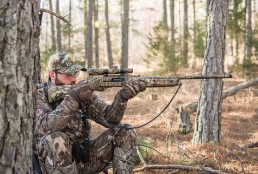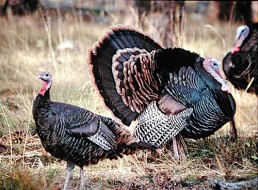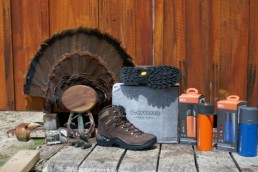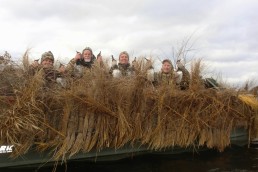How to Solve the Problem of Missing Turkeys
SHARE THIS POST
The only people who don’t miss turkeys are the ones who don’t hunt them. And anyone who says he’s never missed a turkey lies about other things, or he’s never hunted many.
Even after 50 years of hunting wild toms, I know of no worse feeling than spending a morning calling a gobbler to within gun range, squeezing the trigger and watching it run off or fly off. Learning why this occurs, and how to reduce your misses, can make turkey hunting much more fun. I can’t remember all the turkeys I’ve taken, but I do remember most of the turkeys I’ve missed. One of my worst, and the miss I learned the most from, happened when I was hunting Merriam’s turkeys.
I’d just scaled a mountain near Raton, N.M., and was breathing hard. My gun rested on my knee, my cheek was down and my eyes were focused on a giant Merriam’s gobbler no more than 25 yards away.
“Shoot John!” exclaimed Dale Faust, my hunting companion who was sitting next to me.
But the turkey was behind a tree and in full strut. I waited for him to break the strut and stick his neck straight up so that I’d have a better target. As I leaned out around a tree, he broke his strut and put his neck straight up, alarmed at spotting me move. Faust hadn’t brought his gun to his shoulder; he knew this was an easy shot, and one I should have no trouble making.
I fired. But instead of falling over, the turkey ducked and ran. Faust picked up his gun, fired and missed. We both jumped up to chase it. But before I could get my feet under me, I crashed headlong into a pine tree and saw those little white spots before my eyes that football players see when they get their bells rung. I staggered for a few minutes and then regained my feet. I took off on a dead run, chasing that tom and hoping that maybe Faust or I had inflicted a mortal wound. But as we watched, the tom ran off the side of the mountain, took to the air and flew away.
What happened next was the most humiliating moment in my entire turkey-hunting career.
“What happened?” Faust asked, looking back at me in disbelief.
I tried every excuse I could think of to explain the miss, but none of my excuses stood up to the close scrutiny of this master woodsman. We returned to the tree I’d been leaning against when I first shot, and I replayed it over.
As I leaned around the tree with my gun at my shoulder and attempted to aim, Faust said, “That’s it; you’re canting your shotgun.”
I looked down and noticed I had rolled the gun off the side of my shoulder. When I was looking at the turkey, the shotgun actually was pointing about 2 feet to the other side of the bird.
Canting your shotgun
Sometimes, but not often, a gobbler will come walking straight toward the end of your gun barrel, turn sideways and present a broadside neck and head shot. However, more often than not, the turkey will come just slightly to the left or right of where your gun is pointing. You have to move the gun to get a clean shot.
One of the reasons that we tend to cant our shotguns is that our concentration and focus are where we want our patterns to hit the turkeys (their head and the neck areas). So, instead of moving the gun and our shoulder slightly, we’ll roll the stock to the left or to the right, lose the sight picture and miss the turkey. After studying this problem, I feel certain that canting the gun is a major reason I’ve missed turkeys in the past.
Are you enjoying this post?
You can be among the first to get the latest info on where to go, what to use and how to use it!
Adding a riflescope to your turkey gun
Another reason I missed was because I hunted deer for at least three months each year before turkey season arrived. The position where I put my cheek on the stock to aim through my riflescope was higher on the stock than where I put my cheek on my shotgun to aim at a turkey. When I first made these realizations, I decided that if I mounted a riflescope on my shotgun and hunted turkeys with it, I’d at least be putting my cheek on the stock for turkey hunting the same way I did when I was deer hunting with my .30-06. I also learned that if I put the crosshairs that I could see in the scope at the base of the turkey’s neck, I had a much finer aiming point than I would if looking at the bead on the end of my shotgun.
But the major thing I learned was that by looking at the crosshairs, if the vertical line and the horizontal line weren’t straight up and down, and even as I aimed, I could see myself begin to cant the gun. At the time I decided to scope my shotgun years ago, I didn’t know anyone else who was using a riflescope on a shotgun to hunt turkeys. The first time I used my riflescope on my shotgun, I couldn’t believe how accurately I shot it.
In my opinion, putting a scope on your shotgun, whether it’s a red dot scope or a scope with reticles, it will drastically increase your accuracy when turkey hunting. Today’s modern turkey scopes solve many problems.
Let’s look at some other ways hunters miss or wound turkeys besides canting their guns.
Not seeing the aiming point
When a wild turkey comes in to a caller, the hunter recognizes that not only can the bird see better than he can, but also that the tom is searching for movement, specifically a hen that he can’t find. Therefore, any mistake that the hunter makes will spook the bird.
As a gobbler comes in, the hunter should concentrate on these variables:
- Where to allow the bird to get to before he tries to bag him
- Whether bushes and/or trees are between him and the gobbler that will hinder his shot
- When he can move into a shooting position
- Whether the tom will break his strut
- How far the shot is, and whether he should take it
While all this information is going through the hunter’s mind, he also must remember to push off the safety, get his cheek on the stock, look straight down the barrel, superimpose the bead on the turkey’s neck and squeeze the trigger. With processing all this, you can understand how one or two steps may be left out.
For instance, perhaps the hunter doesn’t have his cheek down. Instead, his head may be up looking at the bird. The result will be a miss. Or, perhaps the hunter aims correctly, but doesn’t see a small twig, a little tree or a limb between the bead and the tom. Often, the hunter’s brain is concentrating so hard on the bead of the shotgun and the turkey’s neck that it doesn’t process the information provided by his eyes.
Although there are many reasons that a hunter can miss, even if he does hit the gobbler, he only may wound the bird instead of bringing him down. Turkeys are tough birds; unless a hunter puts a hard lick on the gobbler, the turkey will recover. If the hunter shoots the turkey anywhere except the head and neck, there’s a good chance the bird’s feathers and wings will absorb the shot and prevent it from puncturing the body. Or, if the shot does pierce the turkey’s body, the pellets won’t penetrate far enough to harm a vital organ.
Even if you’re using a turkey scope on your shotgun, you can miss a turkey—and, if you don’t see the crosshairs. When I see the turkey’s head and neck through the scope, I tell myself: See the crosshairs, and put the spot where the reticles intersect at the base of the turkey’s neck.
Once you know why you miss and what you can do to prevent one, you’ll come out of turkey woods many more mornings with a smile on your face, instead of kicking the ground and having a bad rest of the day because you’ve missed your gobbler.
John E. Phillips’ book, “The Turkey Gobbler Getter Manual,” is available at johninthewild.com. To learn more about turkey hunting by Phillips read “The Turkey Hunter’s Bible,” “PhD Gobblers: How to Hunt the Smartest Turkeys in the World,” “Turkey Hunting Tactics,” “How to Hunt Turkeys with World Champion Preston Pittman,” “The 10 Sins of Turkey Hunting with Preston Pittman” and “Outdoor Life’s Complete Turkey Hunting.”
MWO
SHARE THIS POST
Did you enjoy this post?
You can be among the first to get the latest info on where to go, what to use and how to use it!
John Phillips
John E. Phillips’ book, “The Turkey Gobbler Getter Manual,” is available at johninthewild.com. To learn more about turkey hunting by Phillips read “The Turkey Hunter's Bible,” “PhD Gobblers: How to Hunt the Smartest Turkeys in the World,” “Turkey Hunting Tactics,” “How to Hunt Turkeys with World Champion Preston Pittman,” “The 10 Sins of Turkey Hunting with Preston Pittman” and “Outdoor Life’s Complete Turkey Hunting.”




